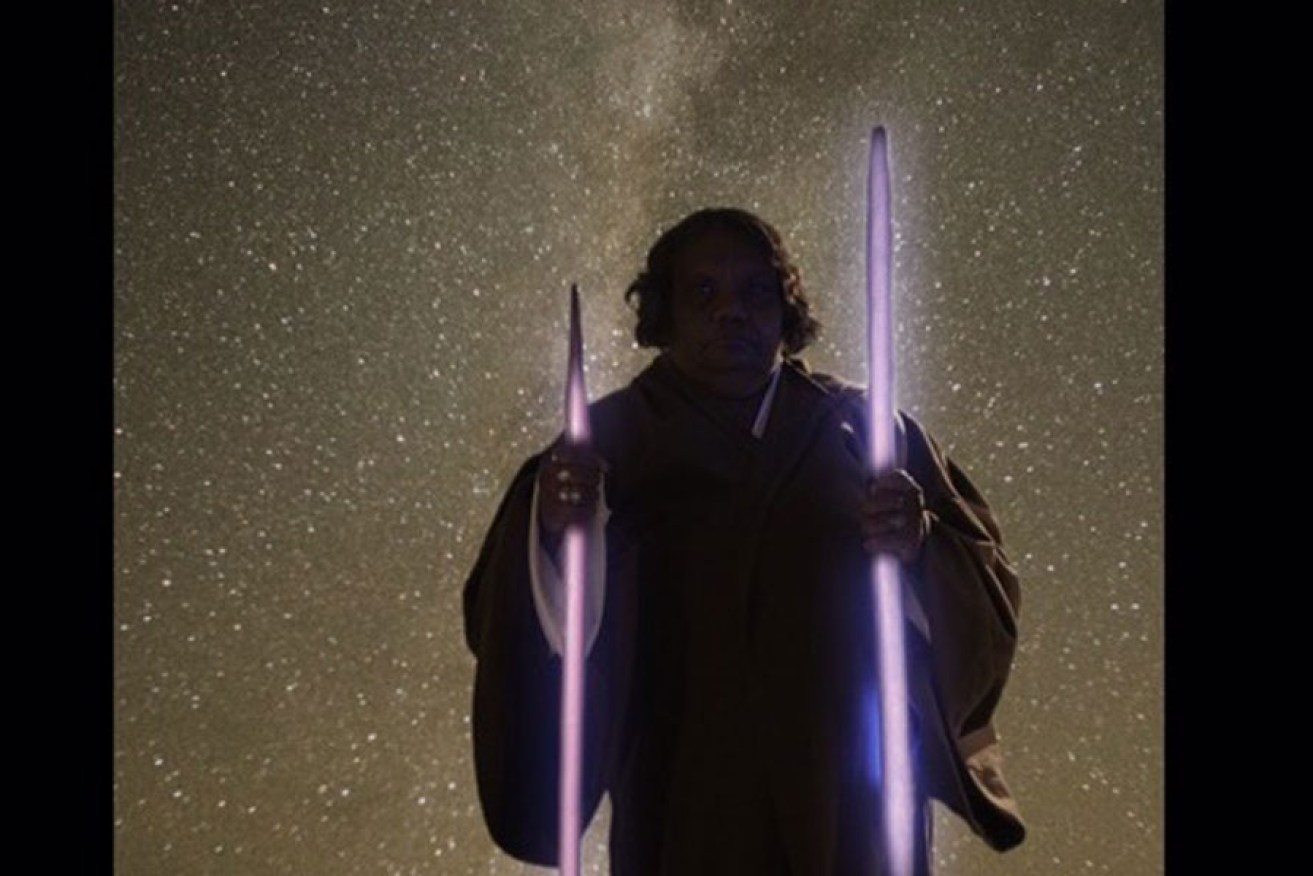May the (art) force be with you

Warwick Thornton, Kaytej people, Northern Territory, Way of the Ngangkari, 2015, still from moving image. Courtesy the artist and Anna Schwartz Gallery
Art Gallery director Nick Mitzevich ponders the proliferation of Aboriginal art beyond the ‘dot’.
Star Wars may seem an unlikely inspiration for the art world, but it’s neither new, nor even particularly novel, for artists to draw upon the force. Last year at the Anne & Gordon Samstag Museum of Art, Adelaide-based artist Roy Ananda recreated the opening text from the film in 3D. Filling the gallery void, and able to be viewed from both levels, Ananda’s tribute, titled Slow crawl into infinity, turned the wonder of sci-fi into back shed DIY.
Commissioned collaboratively by Adelaide Film Festival and TARNANTHI, internationally celebrated artist Warwick Thornton turns his attention to Star Wars in a series of moving image portraits called The Way of the Ngangkari.
Thornton recalls first seeing Star Wars in 1979 at a walk-in theatre in Alice Springs where he still lives today. He remembers being enthralled by the opening text, ‘A long time ago in a galaxy far, far away … ’ In Thornton’s words, “the first thing I did walking out of the cinema was put my shanghai away and pick up a stick. Waving it around like a lightsaber. Fighting for good against evil in the dark of the night.”
Thornton’s enigmatic portraits transform traditional Aboriginal healers, known as Ngangkari, into Jedi. Thornton realized as a young boy, thanks to George Lucas, that there are Jedi all around him. He continues: “In my family we have Jedi. They are not called that; they are called Ngangkari, men and women with special powers that can be used for good or evil. The power to heal and the power to kill. They are recognised at birth and taught the ways of the Ngangkari… Once, when I was six, I got very sick. I was staying with my family out bush, and my aunties asked for an old lady Ngangkari to get the poison that was in my body out. She did so. It was the only time I’ve seen an Aboriginal woman wield a boomerang like a lightsaber, fighting an invisible entity.”
In fact it is the continual reinvention of tradition that marks Aboriginal and Torres Strait Islander art as both ancient and contemporary.
Thornton’s work is not the Aboriginal art that visitors come to the Art Gallery of South Australia seeking. They come in search of desert dot paintings and top end barks. They come in search of a connection to Aboriginal Australia – a way into a culture that is older than any other. And yet here in Thornton’s The Way of the Ngangkari lies a bridge between Aboriginal and non-Aboriginal Australia – one that arguably, due to the global proliferation of Star Wars, is almost universally accessible.
The force of Aboriginal art extends way beyond the power of the ‘dot’. In Tony Albert’s We can be heroes, young Aboriginal men bear targets across their chests. Although this work springs from the vilification that Aboriginal people suffer as ongoing targets of social mistreatment, the proud stance and undeniable beauty of these young men (including the artist himself) is the triumph of resilience and strength over adversity. To return the gaze of these ‘brothers’ is to face our past – to face a history of racism, neglect and abuse – and to commit to a new future, one where we can all be heroes.
TARNANTHI as both a constellation of exhibitions, 22 across Adelaide alone, and a festival, with an art fair at its epicentre, attempts to consciously challenge assumptions about Aboriginal art. But that doesn’t mean that the traditions of Aboriginal art are neglected. In fact it is the continual reinvention of tradition that marks Aboriginal and Torres Strait Islander art as both ancient and contemporary.
This equilibrium is found in the woven forms of Ngarrindgeri artist Yvonne Koolmatrie. Mention of Koolmatrie’s deep ecological knowledge was made in my column in May titled ‘Small, big’ city perfect or artists. Koolmatrie continues an ancient tradition of weaving using river grasses, crafting functional forms such as eel and yabbie traps, alongside the whimsy of hot air balloons and other flying machines.
The University of South Australia’s first Aboriginal student to graduate in glass, Yhonnie Scarce, references the bush food that is frequently the subject of Aboriginal dot painting. She does this, however, using the medium of glass. Made for TARNANTHI, Thunder raining poison is comprised of 2000 bush yams, blown at Adelaide’s JamFactory. The glass yams are suspended in the shape of the nuclear bomb blasts conducted at Maralinga in the north of South Australia between 1953 and 1963.
Elsewhere in TARNANTHI, dot painting prevails and triumphs. A series of works on paper by Gladdy Kemarre celebrate the bush plum, anwekety, a bush food that dominates the ground flora in her country and both an important form of sustenance and a big cultural story. The force of these paintings on paper, with their prolific dotting in deeply saturated colour, cannot be denied.
To conclude with a salute to Lucas, “the force is strong with this one”.
Nick Mitzevich is the director of the Art Gallery of South Australia. He is a regular contributor to InDaily.
TARNANTHI runs across 22 South Australia venues. It opened at the Art Gallery of South Australia last night and continues until January 17, 2016. Riverland: Yvonne Koolmatrie, a highlight exhibition within TARNANTHI also at the Art Gallery of South Australia, runs until January 10.
For more information about TARNANTHI, go here.




